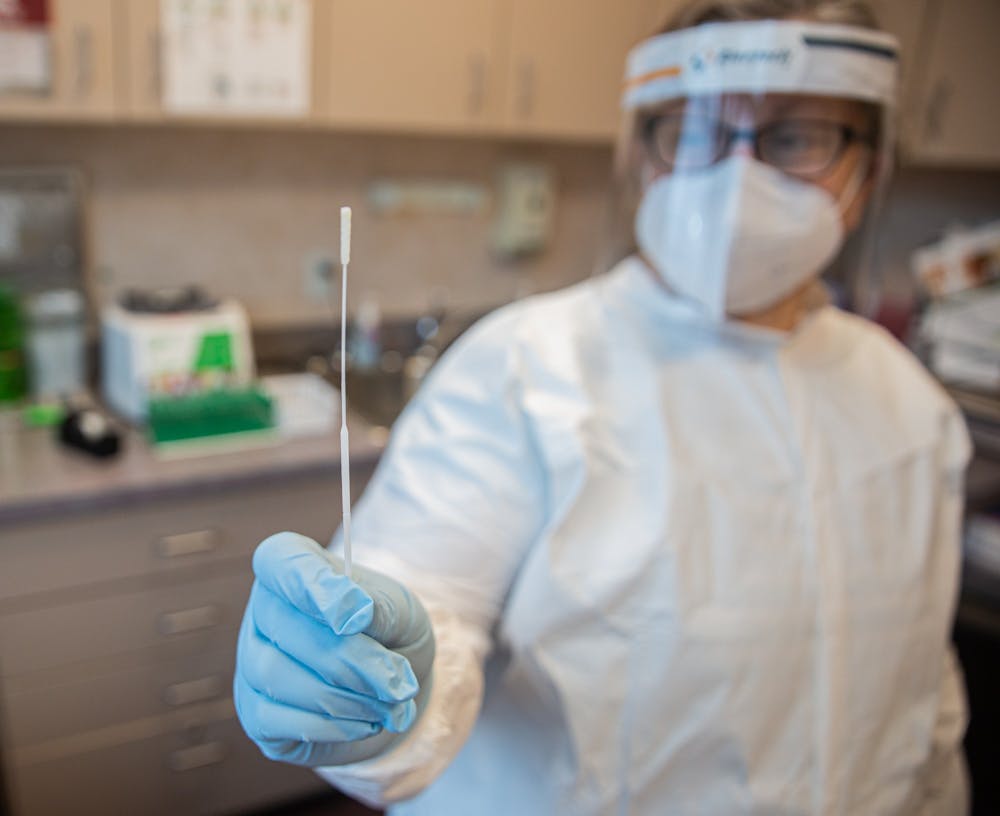University testing response
For students, testing accessibility has increased throughout 2020.
Unlike some other universities, UNC did not mandate entry testing when students returned to campus for the fall semester. It did offer COVID-19 tests through Campus Health, though in August, the process involved long lines and uncertainty.
Many students got tested off campus at places like the FastMed Urgent Care on East Franklin Street, CVS on U.S. Highway 15-501 and Walgreens on LaSalle Street in Durham, which offers rapid test results — sometimes as quickly as 15 minutes.
If a student gets tested off campus, they are supposed to self-report to Campus Health to initiate contact tracing. Only if a student gets tested off campus and is an Orange County resident will the test get reported with the county numbers.
UNC updated its COVID-19 dashboard in September to only reflect the results of tests performed at Campus Health and testing partners with UNC Hospital Respiratory Diagnostic Center. Before, the University said positive test results came from three sources, while negative test reports only came from Campus Health, causing an inaccuracy of the percent of positivity tests.
At the end of September, UNC began offering free saliva-based surveillance testing in the Student Union and encouraged students to get tested every five to nine days.
UNC announced the Carolina Together Testing Program on Nov. 23 for the spring 2021 semester, which involves reentry and regular asymptomatic evaluation testing twice a week throughout the semester for undergraduates. The test will be a self-administered PCR anterior nares nasal swab test, and testing will take place in three campus buildings, according to the Carolina Together website.
State and local collaboration
Now, at the end of 2020, Orange County residents can get a free COVID-19 test almost any day of the week. But tests were not always so accessible.
“If you go back to January, when we first started to learn of this virus coming into the United States, CDC was the only name in town," Scott Shone, director of the North Carolina State Laboratory of Public Health, said. "Everybody who was suspected of having COVID-19 had to have a sample sent to CDC, where they would run it on their own."
The CDC breaks down COVID-19 tests into two types: viral tests, which tell whether a person is currently infected, and antibody tests, which tell if a person had a past infection.
To get the day's news and headlines in your inbox each morning, sign up for our email newsletters.
Shone said technology like rapid antigen tests and PCR have existed for decades, for things like the flu and strep throat.
What’s different now is the demand. Shone said health departments have faced supply shortages throughout the pandemic, and the demand likely won’t be met until next year.
“The supply chains weren’t built for hundreds of millions of people to need the same thing at the same time and every lab trying to buy the exact same thing at the exact same time,” Shone said.
Still, the North Carolina Department of Health and Human Services provides free COVID-19 test kits to local health departments, including the Orange County Health Department.
Orange County offers tests for free at mass-testing events, with no ID required, which take place five days a week in Hillsborough and six days a week in Chapel Hill.
Rebecca Crawford, financial and administrative services director for the Orange County Health Department, said the goal of free testing is ensuring that COVID-19 tests are available to anyone who needs them and to prevent any barriers to testing.
“That is a huge focus from both our elected officials, our commissioners and our health department that says we do not want any barrier to someone being able to be tested,” she said.
The county offers a PCR test using a mid-nasal turbinate, which goes about halfway up the nostril. The county then drops off the sample, contact-free, with the state testing lab.
Crawford said the county health department is in contact with the state health department “all day.” The county health department also coordinates with UNC and private health providers.
“It’s such a cohesive and team effort between all these different entities to ensure that Orange County residents have access to testing,” she said.
Orange County has also made testing accessible in terms of language, staffing the events with interpreters for Spanish, American Sign Language and other languages.
Looking forward
Relative to other counties in North Carolina, Orange County has had few cases and deaths. Crawford said their work preventing the spread could not be done without the support of Orange County residents and the health department workers.
“When you look at the rest of the state, Orange County just pops as pretty safe right now,” she said.
Crawford said the county will begin mobile testing, which will involve traveling to communities where there are COVID-19 clusters but residents may not have transportation to testing.
She also said the health department has been in daily calls with the state and University about plans for administering a vaccine.
Until then, though, the state will continue vigilant testing. Even so, Shone said testing is just part of the public health response that will help get through the pandemic.
“We’re not going to test our way out of the pandemic,” he said. “It’s an essential part of our response, but wearing our masks, washing our hands and waiting our 6 feet, keeping our physical distance, is really what’s necessary.
university@dailytarheel.com




